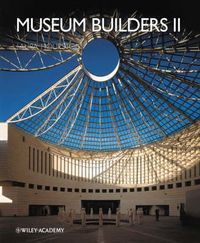
endast ny
Museum Builders II Upplaga 1
The museum has enjoyed an extensive history, but has never been more popular than it is today. With the recent explosion in cultural tourism, museums have been proliferating at an unprecedented rate. Certain fundamental concerns have remained as constant factors in the museum’s story; most notably here, its role as a significant site for the construction and depiction of identity. Museum Builders II explores 27 contemporary museum commissions, which both demonstrate and generate aspects of identity, be they national, ethnic, regional, civic, or personal. The dialogue of ‘identity and difference’ finds many and varied architectural expressions in the contemporary museum buildings highlighted, which are drawn from across the globe. The projects vary dramatically in scale, context, thematics and intent, but all raise questions of architectural representation. Many museum architects have turned to the natural landscape for inspiration, often for aesthetic or pragmatic reasons, but at times to invest their buildings with a specific identity. Similarly, rich archaeological and architectural caches have been plundered by designers in a quest to give identity to their built form. Several featured museum projects address the meeting of cultures, which were defining moments in history, and these encounters have left a tenacious legacy on the architecture and exhibitions of those museums. Most resonant here is the United States Holocaust Memorial Museum: a deeply poignant physical monument to one of the most horrifying and inhumane encounters in human history, and a most extreme example of the museum’s lasting role in the construction and depiction of identities.
Upplaga: 1a upplagan
Utgiven: 2004
ISBN: 9780470849439
Förlag: John Wiley & Sons
Format: Inbunden
Språk: Engelska
Sidor: 224 st
The museum has enjoyed an extensive history, but has never been more popular than it is today. With the recent explosion in cultural tourism, museums have been proliferating at an unprecedented rate. Certain fundamental concerns have remained as constant factors in the museum’s story; most notably here, its role as a significant site for the construction and depiction of identity. Museum Builders II explores 27 contemporary museum commissions, which both demonstrate and generate aspects of identity, be they national, ethnic, regional, civic, or personal. The dialogue of ‘identity and difference’ finds many and varied architectural expressions in the contemporary museum buildings highlighted, which are drawn from across the globe. The projects vary dramatically in scale, context, thematics and intent, but all raise questions of architectural representation. Many museum architects have turned to the natural landscape for inspiration, often for aesthetic or pragmatic reasons, but at times to invest their buildings with a specific identity. Similarly, rich archaeological and architectural caches have been plundered by designers in a quest to give identity to their built form. Several featured museum projects address the meeting of cultures, which were defining moments in history, and these encounters have left a tenacious legacy on the architecture and exhibitions of those museums. Most resonant here is the United States Holocaust Memorial Museum: a deeply poignant physical monument to one of the most horrifying and inhumane encounters in human history, and a most extreme example of the museum’s lasting role in the construction and depiction of identities.
Ny bok
750 kr789 kr
5% studentrabatt med Studentapan
Begagnad bok (0 st)
Varje vecka tillkommer tusentals nya säljare. Bevaka boken så får du meddelande när den finns tillgänglig igen.



